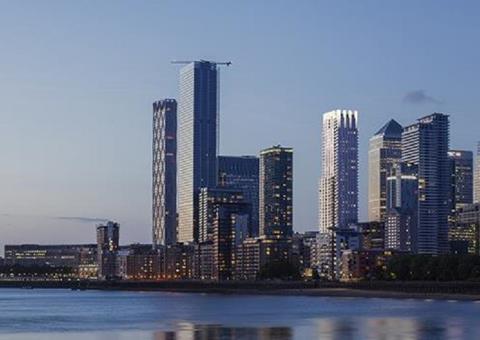All planning applications must include the fire safety measure before going to the Greater London Authority for stage 2 approval
London mayor Sadiq Khan has said all planning applications for new buildings above 30m must now have second staircases before going to the Greater London Authority (GLA) for final sign off.
The fire safety measure has been brought in with immediate effect, the GLAŌĆÖs planning department said.
It follows the governmentŌĆÖs launch of a consultation in December last year on requiring developers to include second staircases in blocks above 30m, which is around 10 storeys.
The move has long been called for by RIBA, despite not being a recommendation in Judith HackittŌĆÖs review of building safety regulations conducted in the aftermath of the 2017 Grenfell fire.
The Department for Levelling Up, Housing and Communities said it wants to bring in the measure with a ŌĆ£very shortŌĆØ transition period and was encouraging ŌĆ£all developments to prepare for this change nowŌĆØ.
It expects the requirement to cost the construction industry ┬Ż1.6bn over the next 10 years.
The GLA planning department said: ŌĆ£The mayor has consistently expressed concerns that the fire safety requirements in the national ║┌Č┤╔ńŪ° Regulations are not fit for purpose, so the proposed strengthened requirements and clear direction at the national level are strongly supported.ŌĆØ
The statement said in light of the short transition period envisaged by the government and the requirements of the London Plan for all developments to achieve the highest standards of fire safety, the department is ŌĆ£clear that, with immediate effect, all planning applications which involve residential buildings over 30m in height will need to be designed to provide two staircases before they are referred to us at Stage 2 for the mayorŌĆÖs decision.ŌĆØ
The department added: ŌĆ£The GLAŌĆÖs planning team is working with the boroughs to progress schemes which are currently in the pipeline to ensure they include two staircases where necessary before any Stage 2 referral.

ŌĆ£We are all working hard to look at feasible options to secure this and try to meet key timescales, particularly given the impact planning delays may have on affordable housing grant funding.ŌĆØ
> Also read: What the second staircase rule would mean for high rise blocks
The GLAŌĆÖs housing and land departments said that all schemes which had been approved by the GLA before 23 December 2022 and were eligible for funding would remain eligible.
The governmentŌĆÖs consultation said last year the requirement for second staircases would not allow ŌĆ£scissorŌĆØ stairwells which interlock, and would not protect against the spread of smoke from one stairwell to another.
As far back as 2018 the RIBA said in its response to the Hackitt report that all high-rise buildings should have more than one means of escape ŌĆō with the architectsŌĆÖ body at the time recommending a second stairwell be required in 11m buildings or higher.
In December the National Fire Chiefs Council called for all buildings above 18m in height to have the same requirement.
The departmentŌĆÖs consultation said the 10-year cost to business would rise to ┬Ż3.7bn if it had implemented the requirement at 11m-plus, or ┬Ż2.5bn for 18m-plus.
The move comes after developer Ballymore last year pulled plans for a 52-storey tower in LondonŌĆÖs Docklands and later redesigned it with a second stairwell following pressure from campaigners and the London Fire Brigade over the issue.
The same consultation also proposed a number of other significant changes to the system for fire safety regulation, proposing to mandate sprinkler systems in care homes at all heights, and to finally remove all references to the old British Standard national product classification system from building regulations ŌĆō known as the BS476 series.
This is the system, long ago supposed to have been superseded by the European products regulation system but was never formally removed from the regulations, which contained the ŌĆ£class 0ŌĆØ rating which caused much confusion in the approved documents. A Class 0 rating only refers to the surface of a product being of limited combustibility, while the internal composition of the product can remain flammable.
In addition, the consultation, which will run until 17 March, is consulting on potential amendments to the wording of the key paragraphs in the Approved Documents guidance covering the make-up of external walls on high-rises ŌĆō paragraphs 10.6 and 10.7.



























No comments yet